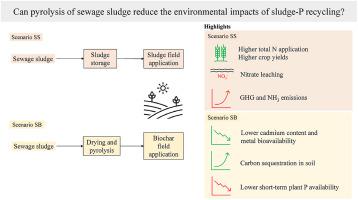当前位置:
X-MOL 学术
›
J. Clean. Prod.
›
论文详情
Our official English website, www.x-mol.net, welcomes your feedback! (Note: you will need to create a separate account there.)
Application of untreated versus pyrolysed sewage sludge in agriculture: A life cycle assessment
Journal of Cleaner Production ( IF 11.1 ) Pub Date : 2024-04-15 , DOI: 10.1016/j.jclepro.2024.142249 Maja Rydgård , Asimina Bairaktari , Gunnar Thelin , Sander Bruun
Journal of Cleaner Production ( IF 11.1 ) Pub Date : 2024-04-15 , DOI: 10.1016/j.jclepro.2024.142249 Maja Rydgård , Asimina Bairaktari , Gunnar Thelin , Sander Bruun

|
Recycling of phosphorus (P) from waste streams such as sewage sludge to agriculture is essential in order to ensure future food security. Land application of sewage sludge is controversial due to its content of pollutants, such as heavy metals and toxic organic compounds. Pyrolysis is a technology that can eliminate harmful contaminants while enabling the recycling of P in the sludge. Organic pollutants are degraded during pyrolysis, while most of the P remains and approximately 40 % of the carbon is retained in a stable form in the biochar. When performing pyrolysis at a temperature of around 800 °C or more, cadmium is evaporated and can be separated from the biochar. Electricity-driven pyrolysis facilitates this by means of easier temperature control. The aim of the present study was to undertake a Life Cycle Assessment (LCA) to evaluate the environmental impacts of high-temperature electricity-driven pyrolysis of sewage sludge, including the separation of cadmium, and field application of sludge biochar as compared with sewage sludge storage and field application. The results showed that pyrolysis can offer a more climate-friendly solution due to avoided greenhouse gas emissions from the sludge and to carbon sequestration of the biochar. However, field application of untreated sludge resulted in a higher application of nitrogen (N) and more plant-available P. Agricultural modelling tools indicated that this produces higher crop yields than biochar application. In the LCA model, higher crop yields lead to savings in land use and water consumption as the higher yields can replace other crop production. The lower plant availability of biochar P implies a possible risk of lower yields when the P application is restricted based on total P, and a risk of greater P loss with soil erosion to the environment. Overall, the present study stresses the importance of including the long-term agronomic impacts of sludge and biochar field application in LCAs, and highlights the trade-offs that need to be considered in decision-making regarding the implementation of pyrolysis technology.
中文翻译:

未经处理与热解污泥在农业中的应用:生命周期评估
为了确保未来的粮食安全,将污水污泥等废物流中的磷 (P) 回收到农业中至关重要。由于污水污泥含有重金属和有毒有机化合物等污染物,其土地利用存在争议。热解是一种可以消除有害污染物,同时回收污泥中磷的技术。有机污染物在热解过程中被降解,而大部分磷保留下来,约 40% 的碳以稳定形式保留在生物炭中。当在约800°C或更高的温度下进行热解时,镉被蒸发并且可以从生物炭中分离出来。电力驱动的热解通过更容易的温度控制来促进这一点。本研究的目的是进行生命周期评估(LCA),以评估污水污泥高温电驱动热解对环境的影响,包括镉的分离,以及与污水污泥相比污泥生物炭的现场应用储存和现场应用。结果表明,由于避免了污泥的温室气体排放和生物炭的碳封存,热解可以提供更加气候友好的解决方案。然而,未经处理的污泥的田间施用导致氮 (N) 的施用量更高,植物可利用的磷含量也更高。农业建模工具表明,这比施用生物炭产生更高的作物产量。在 LCA 模型中,较高的作物产量可以节省土地使用和水消耗,因为较高的产量可以取代其他作物生产。植物对生物炭 P 的利用率较低,意味着当基于总磷限制磷的施用时,可能存在产量较低的风险,并且随着土壤侵蚀对环境造成更大的磷损失的风险。总体而言,本研究强调了将污泥和生物炭现场应用的长期农艺影响纳入 LCA 的重要性,并强调了在实施热解技术的决策中需要考虑的权衡。
更新日期:2024-04-15
中文翻译:

未经处理与热解污泥在农业中的应用:生命周期评估
为了确保未来的粮食安全,将污水污泥等废物流中的磷 (P) 回收到农业中至关重要。由于污水污泥含有重金属和有毒有机化合物等污染物,其土地利用存在争议。热解是一种可以消除有害污染物,同时回收污泥中磷的技术。有机污染物在热解过程中被降解,而大部分磷保留下来,约 40% 的碳以稳定形式保留在生物炭中。当在约800°C或更高的温度下进行热解时,镉被蒸发并且可以从生物炭中分离出来。电力驱动的热解通过更容易的温度控制来促进这一点。本研究的目的是进行生命周期评估(LCA),以评估污水污泥高温电驱动热解对环境的影响,包括镉的分离,以及与污水污泥相比污泥生物炭的现场应用储存和现场应用。结果表明,由于避免了污泥的温室气体排放和生物炭的碳封存,热解可以提供更加气候友好的解决方案。然而,未经处理的污泥的田间施用导致氮 (N) 的施用量更高,植物可利用的磷含量也更高。农业建模工具表明,这比施用生物炭产生更高的作物产量。在 LCA 模型中,较高的作物产量可以节省土地使用和水消耗,因为较高的产量可以取代其他作物生产。植物对生物炭 P 的利用率较低,意味着当基于总磷限制磷的施用时,可能存在产量较低的风险,并且随着土壤侵蚀对环境造成更大的磷损失的风险。总体而言,本研究强调了将污泥和生物炭现场应用的长期农艺影响纳入 LCA 的重要性,并强调了在实施热解技术的决策中需要考虑的权衡。



























 京公网安备 11010802027423号
京公网安备 11010802027423号